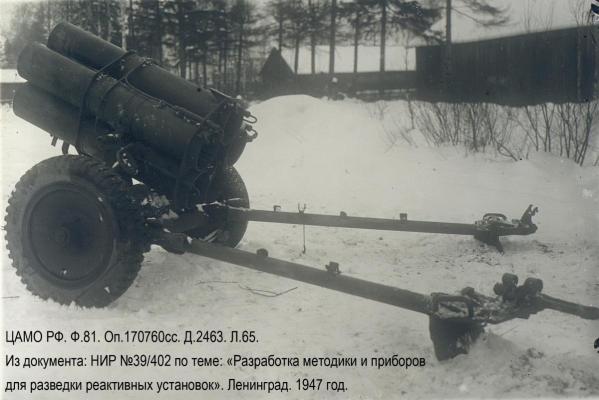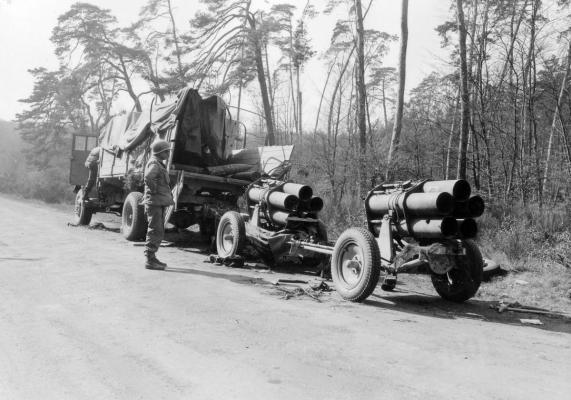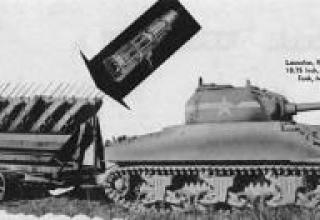The German 210 mm towed mortar Nb.W.42 (21cm Nebelwerfer 42) was designed to destroy solid wood-earth fortifications and defeat enemy manpower. The Nb.W.42 (21cm Nebelwerfer 42) was a 210mm unguided Wgr.42 mortar, which could be fired in full volley every eight seconds at a range of up to 8000 meters. The mortar went into service with the Wehrmacht in 1942.
The Nebelwerfer 42 mortar was used on all fronts of the Second World War (see, for example, the photo of Tunisia, Western Front, April 1943).
From 1943 the projectile was used in the air force (Luftwaffe) of fascist Germany. Single barrels Nb.W.42 were mounted under the wing of some Fokke Wolf FW-190 fighters. (Nebelwerfer 42 CWM 19500013-001 - see photo) that used the Wgr.42 mines as air-to-air missiles. The mines used in this version were known as Wfr. Gr. 21 (Wurframmen Granate 21) or BR 21 (Bordrakete 21).
Plant production Nb.W 42:
Total: 1487 pcs. |
Manufacture of mines Wgr.42:
Total: 402580 pcs. |
Canadian soldiers called the Nb.W 42 "Moaning Minnie" mortar because of the characteristic sound that accompanied the flight of the mines, and American troops in Italy - "Screaming Mimi". The U.S. military nicknamed the Wgr.W 42 "flaming baseballs" because the flight of the mine at night resembled that of a ball of fire. The plant is currently exhibited in museums in Canada (see photo_1, photo_2) and the USA.
Composition:
According to domestic data, the mortar design included a block of barrels, gun carriage PAK 35/36 of 37 mm caliber and sighting devices.
The Nb.W.42 mortar was a rigid smooth-bore system of 5 barrels, which were fastened with two straps - front and rear. Each barrel had three guides, arranged at an angle of 120° to each other. The mortar barrels were oscillating parts superimposed on the studded socket of the upper machine gun. The upper machine was rotated along the lower one by a toothed sector of the rotary mechanism.
To charge the mortar, it was led to the charging angle (at large elevation angles) and charged with mines from the breech block, then pyropatroons were inserted into the corresponding mine nozzles.
The mortar was towed by wheeled and half-tracked vehicles (photo_1, photo_2), as well as by human traction for short distances.
The main structural elements of the mine were: ballistic tip, fuse, head end, missile end. The missile part consisted of: a hull, 7 powder charges, aperture, ring, ignition system of the charge with a cap 65 mm in diameter, turbine and other structural elements.
Checkers were packed in cardboard cylindrical capping and placed in a wooden box. Two cappings, i.e. 14 checkers, were placed in one box.
A bracket with a clamp and a key were used for twisting and unwinding the turbine.
In order to prevent spontaneous unwinding of the head and combat unit, they were locked in the place of threaded connection, presumably with a locking screw (according to German data).
According to domestic data, the shrapnel-fluid combat unit consisted of a cast steel case equipped with ammatol (ammonium nitrate - 31.13%, TNT - 68.8%), a L.J.gr.Z23nA. fuse with a wooden cigarette, a detonator bushing with a detonator and a ballistic tip. The use of ammatol with a high content of TNT was caused by the fact that the crushing of the combat chamber of the projectile, made of cast steel with a time resistance of 54 kg / mm2, required a stronger than usual German ammatol with a ratio of components: ammonium nitrate - 40%, TNT - 60%. Besides, ammatol of the specified composition increased blast action of a combat unit.
The ballistic tip was made of cast iron /standard grey cast iron/.
The L.J.gr.Z23nA fuse is an unbreakable type, instantaneous and delayed action. The fuse consisted of a three-part body, a double-acting impact mechanism and a retarder. The advantage of the LJgrZ23nA was that it consisted almost entirely of parts and assemblies of pre-existing fuses. This factor accelerated and reduced the cost of mass production. The disadvantage of the fuse was the difficulty of making individual parts and assemblies. For example, according to the German magazine AllgemeineHcheresmitteilungen (Berlin, 1942), the manufacture of centrifugal rotary dies and especially their assembly in relation to the axis of the body and in relation to one another were associated with great difficulty. The retarded arrangement was also difficult to produce and gave rise to a higher failure rate of the fuses when set to slow down.
The missile portion of the mine consisted of a steel missile chamber, a rocket charge, lower, transmission and upper ignitors, an aperture and a nozzle bottom (turbine). The missile chamber consisted of a steel beaker, with a thread at the bottom for connection to the nozzle bottom and a thread at the top for connection to the projectile warhead.
The missile charge consisted of seven single-channel draughts of dinitroglycol powder, one draughts in the center and six in the periphery. When fired, the rocket charge was ignited by means of a pyropatron inserted into one of the side nozzles. Under the action of gunpowder rocket charge gases flowing through the nozzle orifices, the mine received progressive and rotational motion, providing stability in flight.
Chemical composition of the gunpowder rocket charge:
- Pyroxylin 59.67%;
- Dinitroglycol - 33.83%;
- Nitroderivatives - 5.41%;
- Vaseline - 0,67%.
- Nitrogen content in powder pyroxylin - 12,41%.
Transportation of Wgr.42 mines was carried out in the caps of indices 4662 A and 4662 B.
Characteristics:
| Weight in combat position, kg | 577,5 |
| Angle of horizontal guidance | ±14° |
| Largest elevation angle | 0°10' |
| Mortar length in hiking position, mm | 3345 |
| Largest mortar width, mm. | 2620 |
| Mortar height in hiking position, mm | 1450 |
| Wheel axle height, mm | 410 |
| Clearance, mm | 340 |
| The highest elevation angle (with openers buried in the ground) | +45° |
| Maximum declination angle | -10°10' |
| Angle of horizontal guidance | ±14° |
| Trunk length, mm | 1289÷1300 |
| Diameter along barrel guides, mm | 215,0÷216,1 |
| Angle of guideways | 120° |
| Weight in the fighting position (without a baton with ZIP and sight), kg | 577,5 |
| Mortar length in combat position at an elevation angle of 0°, mm | 3160 |
| Mortar length in hiking position, mm | 3345 |
| Distance from coulter support axis to wheel axle, mm | 2080 |
| Distance from coulter support point to trunnion axle, mm | 2070 |
| Maximum width of the mortar (on extended bases), mm | 2620 |
| The width of the mortar on the stroke axis, mm | 1675 |
| Running width in the middle of the tyres, mm | 1425 |
| Mortar height in combat position at an elevation angle of 0°, mm | 1428 |
| Mortar height in hiking position, mm | 1450 |
| Height of the stud axle, mm | 965 |
| Wheel axle height, mm | 410 |
| Clearance, mm | 340 |
| Largest elevation angle (coulters are not buried in the ground) | 41°25' |
| Largest inclination angle (coulters are not buried in the ground) | 10°10' |
| Angle of horizontal guidance | 41°/±14°/ |
| Barrel length, mm | 1289-1300 |
| Barrel outer diameter, mm | 240,5-242 |
| Inner diameter, mm | 236÷237,5 |
| Diameter along barrel guides, mm | 215 |
| Height of guides, mm | 10,5÷10,7 |
| Angle of guideways | 120° |
| Weight in the fighting position (without a box with ZIP, chance tool and sighting), kg | 577,5 |
| Weight of the oscillating part, kg | 199 |
| Weight of the rotating part, kg | 254,5 |
| Weight of the top machine, kg | 55,5 |
| Weight of one wheel, kg | 78,5 |
| Weight of the bottom machine, bed, undercarriage and front stop wheels, kg | 325 |
Characteristics of 210 mm rocket projectile of 1943 sample.
| Total weight of the projectile in final equipment, kg | 110,370 |
| Passive weight of projectile, kg | 92,240 |
| Total length, mm | 1210 |
| Maximum speed / computed/,m/sec | 358,6 |
| Range at elevation angle 45°, m | 7973 |
| Tightness when shooting at an angle. | 45° |
| TD/H | 1/88 |
| W/X | 1/76 |
| Weight of combat unit (BC) , kg | 42,320 |
| Weight BC (without ballistic tip and fuse), kg | 42,320 |
| BC length (with ballistic tip), mm | 550 |
| Ballistics tip weight, kg | 2,130 |
| Ballistics tip length, mm | 220 |
| Fuse weight, kg | 0,450 |
| Weight of explosive charge, kg | 9,27 |
| Weight of the rocket part, kg | 68,050 |
| Outer diameter, mm | 62,5 |
| The diameter of the channel, mm | 7,7 |
| The length of the checker, mm | 550 |
| Draughts number | 7 |
| Weight of one checker, kg | 2,590 |
| Weight of all charges, kg | 13,130 |
| Ignitants | black smoke gunpowder |
| The weight of the rocket chamber, kg | 41,265 |
| Weight of the rocket powder charge, kg | 18,130 |
| Weight of lower ignition, kg | 0,100 |
| Weight of upper ignition, kg | 0,090 |
| Transmission ignition weight, kg | 0,010 |
| Diaphragm weight, kg | 0,670 |
| Shock absorber weight, kg | 0,115 |
| Nozzle bottom weight, kg | 7,670 |
| Dimensions and design data | |
| The length of the missile part, mm | 680 |
| The diameter of the cylindrical part of the missile chamber, mm | 209 |
| Number of inclined nozzle orifices | 22 |
| Number of straight nozzle orifices | 1 |
| Diameter of critical cross-section of inclined nozzles, mm | 9 |
| Diameter of critical cross section of straight nozzle, mm | 9 |
| Output diameter of inclined nozzles, mm | 21 |
| Output diameter of straight nozzle, mm | 23 |
| Input diameter of inclined nozzles, mm | 11 |
| Input diameter straight nozzle | 10 mm |
| Tilt angle of the nozzle holes | 15°30' |
| Number of missile charge checkers | 7 |
| The length of the checker, mm | 550 |
| Checker outer diameter, mm | 62,5 |
| Diameter of the channel/internal diameter of the draughts, mm | 7,7 |
| Thickness of the burning vault /2e/, mm | 27,4 |
| Powder grain | persistent burning |
| Initial combustion surface, m2 | 0,89152 |
| Inner chamber diameter, mm | 190,03 |
| How to connect the nozzle bottom to the missile chamber | 4M190×15 thread |
Testing:
From September 1 to November 28, 1945, the Nb.W.42 trophy mortar was tested at the Red Army State Automobile and Space Administration. The tests were carried out on the basis of the order of the Deputy Chief of SAKP, Major-General of the Engineering and Artillery Service of Serebryakov under the program of the range - SAKP task №4410.
In the report No 0116 dated 19.1.46 the description of the device and operation of the Wgr.42 mine, L.J.gr.Z23nA fuse and the mortar were given. Data on the heap and range, as well as theoretical calculations of internal and external ballistics are given. In addition, the report contains the results of analysis of the hull materials and equipment. The test manager was Captain Lerner.
The purpose of the tests was to determine:
- basic characteristics of the mortar and the mine Wgr.42 /description of the device, operation and purpose/.
- Intraballistic characteristics Wgr.42 /powder gas pressure and charge burn time/.
- aerodynamic characteristics Wgr.42 (wind tunnel blowing).
- The impact and maximum mine speed and the nature of mine buildup in the active area.
- Maximum range at 10°, 20°, 30° and 45° elevation angles.
- The mine's blast and fragmentation effect on the target.
- the system's strength, stability and rate of fire.
When measuring five minutes on centering belts, the projectile caliber was 214 mm, so the report suggested "counting the caliber not 210 mm as usual, but 214 mm".
The conclusions of report No. 0116 were as follows:
- The 210 mm Wgr.42 rocket projectile with the M-13UK missile was characterized by simplicity, cheapness and availability of materials that were used for its production. It was noted that the Germans considered it possible for missile chambers to allow deformation at maximum pressure beyond the elastic limits, i.e. the chambers were calculated not on the elastic limit, but on the temporary resistance to rupture with a margin of strength of the order n=1.5.
- Manufacturing of dinitroglycol powders for rocket charges had advantage in comparison with manufacturing of nitroglycerine powders. As glycol was based on cheap raw material base (vegetable oils), and glycerin was mainly produced from animal fats.
During the study of the mine, it was disassembled into structural elements. See their photos: photo 1, photo 2, photo 3, photo 4, photo 5, photo 6, photo 7.
From August 8th till August 13th 1945 at the State Mine Stockpile of Ukraine there were conducted shooting to determine experimental data for drawing up tables of shooting. Shots were fired at an elevation angle of 10°, 20°, 30° and 45° (maximum possible elevation angle).
The mortar was simultaneously loaded with 5 shells. The mortar was fired in single shots. The charge was corrected after each shot, and the shoot down rate was insignificant. Due to lack of German mortar sight, side aiming was made with MP-41 sight.
As a result of tests it was received:
- The puchiness and range of the 210 mm Wgr.42 missile did not differ from the characteristics of the domestic M-13UK projectile. When the angle of Ө decreases (elevation angle) the heap drops sharply especially in range: gri Ө=10° the range of 2650m and the WDX = 1/17 was obtained; WDX = 1/58, at Ө=45° the range of 8000 m and the WDX = 1/88; WDX = 1/76.
- The effect of the Wgr.42 mine on the target was undoubtedly more powerful than that of the M-13UK, as the 210mm projectile carried 9.27 kg of explosives, while the M-13UK carried 4.55 kg. However, the Wgr.42 has a smaller fill factor /WB to passive weight ratio than the M-13UK. The M-13UK had a filling ratio of 13% and Wgr.42 had a filling ratio of 10%.
- The design of the Wgr.42 mine was characterized by the simplicity, affordability and accessibility of the materials used in its manufacture.
- Calculation of internal ballistics showed the following results: at charge temperature - 40°C the pressure in the chamber was equal to 106 kg/cm2, at charge temperature +40°C the pressure was equal to 325 kg/cm2. This gave grounds to suppose that the rocket charge will work at low temperatures and will not break the chamber at high ones.
- The chemical composition and physical characteristics of the gunpowder rocket charge did not differ from glycol powders, which were adopted in German artillery. Powder strength and caloric value were of the same order as M-13UK rocket charges, but the use of glycol undoubtedly extended the raw material base of the powder production.
- The design of the 210-mm 5-barrel Nb.W.42 mortar carriage did not differ from that of the 150-mm 6-barrel Nb.W.41 mortar carriage.
- The maneuverability and ease of operation are satisfactory, but the power of the 210 mm mortar salvo is about 1.5 times smaller than that of the BM-13. For one salvo of 5-barrel mortar ejected 46 kg ВВ, and installation BM-13 - 73 kg ВВ.
It was concluded that the design of the 210 mm Nb.W.42 rocket launcher and its projectile was found to be successful, both in combat and operational terms.
The mortar was disassembled into its structural elements during its study. See their photographs: photo 1, photo 2, photo 3, photo 4, photo 5, photo 6, photo 7, photo 8.
Sources:
- ЦАМО РФ. Ф.81. Оп.170760сс. Д.8. ЛЛ.1-6,10-12,14-18,21-23,28,29,31,33,34,40-42,44,45,48,52-56.
- http://sturmvogel.orbat.com/GermWeapProd.html
- http://en.wikipedia.org/wiki/Nebelwerfer
- Bundesarchiv_Bild_101I-787-0505-09A,_Nordafrika,_21cm_Nebelwerfer.jpg
- http://en.wikipedia.org/wiki/File:Bundesarchiv_Bild_101I-787-0505-09A,_Nordafrika,_21cm_Nebelwerfer.jpg
- http://www.loutan.net/olivier/archives/2007/11/29/nebelwerfer-42/
- http://upload.wikimedia.org/wikipedia/commons/b/b4/Bundesarchiv_Bild_101I-155-2109A-07A%2C_Russland%2C_Halbkettenfahrzeug_mit_Nebelwerfer.jpg
- http://upload.wikimedia.org/wikipedia/commons/b/b4/Bundesarchiv_Bild_101I-155-2109A-07A%2C_Russland%2C_Halbkettenfahrzeug_mit_Nebelwerfer.jpg
- http://knigi.tr200.biz/index.php?id=2483495
- http://www.flickr.com/photos/dugspr/2467685894/sizes/o/in/photostream/
- http://www.flickr.com/photos/dugspr/2467685894/in/photostream/
- http://www.flickr.com/photos/dugspr/2466861657/in/photostream/2466861657_ee4b90375a_o.jpg
- http://www.flickr.com/photos/dugspr/2466861657/sizes/o/in/photostream/
- http://upload.wikimedia.org/wikipedia/commons/b/ba/Bundesarchiv_Bild_101I-674-7772-13A%2C_Flugzeug_Focke-Wulf_Fw_190%2C_Bewaffnung.jpg?uselang=ru
- http://commons.wikimedia.org/wiki/File:Bundesarchiv_Bild_101I-674-7772-13A,_Flugzeug_Focke-Wulf_Fw_190,_Bewaffnung.jpg?uselang=ru
- http://ru.wikipedia.org/wiki/21_cm_Nebelwerfer_42






